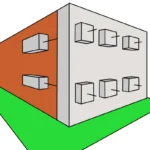What are Sub-Drainage Works?
Sub-drainage works refer to installations and structures designed to manage and control internal water that affects the stability of roads. The main objective of these works is to reduce the adverse effects of internal water on roadways and embankments. Some features and objectives of sub-drainage works include:
Internal Water Control: Sub-drainage works are intended to control internal water that may arise from both the interior (capillary rise) and the exterior (water sources on slopes or banks).
Facilitating Construction: They contribute to the execution of embankments during the road construction phase, helping manage water that could hinder the works.
Improving Stability: They aim to increase the bearing capacity of the subgrade, thereby reducing pavement thickness. Additionally, they contribute to slope stability by favorably orienting internal water flows and reducing interstitial pressures.
On the other hand, road drainage works refer to structures designed to control surface water on roads. These works deal with managing rainwater that accumulates on the road surface and ensure its efficient evacuation. Some road drainage works may include gutters, culverts, and other devices to collect and channel rainwater away from the road.
How Does Moisture Manifest Itself?
While we know that rainwater affects the surface of roads, the need for these sub-drains arises from the following forms in which moisture can present itself:
1. Capillary Rise:
Water can manifest itself through capillary rise from the water table, either through liquid or vapor suction phenomena. To better understand this, we must grasp how “Capillary Moisture” works.
What is Capillary Moisture?
Capillary rise is a phenomenon where water ascends through a porous medium, such as soils, rocks, or construction materials, against gravity. This process occurs due to the capillaries’ ability (small interconnected spaces within the material) to attract and retain water.
In the context of road construction or structures, capillary rise can be a problem when water rises from the water table through the pores of soils or materials used in construction. This phenomenon can cause various inconveniences, such as damage to structures, affecting soil stability, and constant moisture presence.
In the case of roads, if not properly managed, capillary rise can contribute to the continuous presence of water in the subgrade and affect road stability. For this reason, sub-drainage works implement measures to control and mitigate capillary rise, such as installing drainage systems to help evacuate internal water and maintain drier conditions in the road structure.
2. Water Sources on Slopes or Banks:
Isolated or distributed water sources may appear on slopes or embankments, not only complicating the construction of new works but also compromising road stability after construction.
3. Infiltration of Rainwater:

Although part of the rainwater is drained through surface drainage devices, a portion can infiltrate through slopes, berms, or even occasionally through the pavement.
What Sub-Drainage Devices Exist?
Primarily, two are commonly used:
Longitudinal Sub-Drains:
Longitudinal sub-drains are essential components in the internal drainage system of roads, playing a fundamental role in managing groundwater. Their design and function are specifically oriented to address various hydrogeological and geotechnical challenges associated with road construction and maintenance. Here is a detailed explanation of longitudinal sub-drains:
Definition and Function:
Longitudinal sub-drains are channels or pipes arranged along the road, usually in cut areas, with the main purpose of lowering the water table, removing filtration water, and diverting water sources below the subgrade. These devices significantly contribute to maintaining the stability of road infrastructure by efficiently controlling the flow of groundwater.
Installation and Design:
The arrangement and design of longitudinal sub-drains are critical to their effectiveness. They are generally placed on both sides of the road’s embankment, in strategic areas where groundwater may pose a challenge. Proper installation involves considering the slope of the terrain and the depth at which water sources are located, ensuring efficient capture.
Additional Benefits:
In addition to their primary function in controlling groundwater, longitudinal sub-drains can also contribute to improving the geotechnical properties of the soil, reducing interstitial pressures, and thereby increasing slope stability.
Draining Layers:
Draining layers are key elements in the internal drainage system of roads, playing a crucial role in managing filtration water and preventing issues associated with water accumulation in the subgrade and pavement layers. Here is a detailed explanation of draining layers and their distinctive features:
Definition and Purpose:
A draining layer is a specific stratum within the road structure designed to collect and eliminate filtration water. Its main purpose is to prevent water accumulation in the subgrade and improve the pavement’s bearing capacity by keeping the soil free from saturation.
Location and Construction:
Draining layers are strategically located in cut or fill areas, depending on the topography and hydrogeology of the area. In cut areas, they are built on the subgrade as the first layer of the pavement, while in fill areas, they are placed between the natural ground and the fill body.
Connection with Other Drainage Elements:
A crucial feature of draining layers is their connection with other elements of the internal drainage system. They are typically imperative connections with longitudinal sub-drains, forming an integrated system that ensures effective groundwater management.
Specific Characteristics:
Draining layers are typically composed of granular materials such as gravel or sand, allowing rapid water drainage. Additionally, their permeability and ability to resist compression are essential characteristics for their effective long-term operation.
Adaptability to Specific Conditions:
The construction of draining layers can be adapted to the specific geotechnical conditions of the site, such as the presence of water sources, by incorporating oblique sub-drains arranged in a fishbone pattern.







Related
10 Things You Didn’t Know About Civil Engineering.
What Are Trusses? – Civil Engineering